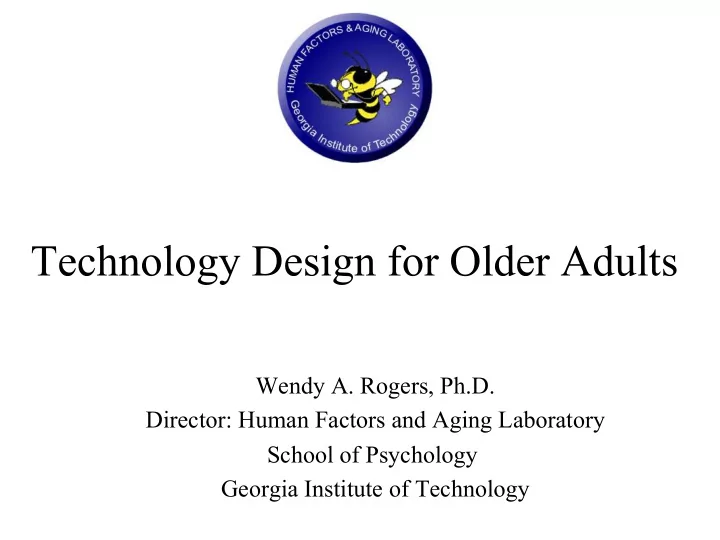

Technology Design for Older Adults Wendy A. Rogers, Ph.D. Director: Human Factors and Aging Laboratory School of Psychology Georgia Institute of Technology
How ¡can ¡technology ¡ENHANCE ¡the ¡lives ¡of ¡older ¡adults... ¡ ¡ ...by ¡enabling, ¡augmen=ng, ¡empowering, ¡advancing, ¡ energizing, ¡engaging, ¡etc.? • Develop strategies to match technology support with active engagement • Balance between technology support, augmentation, replacement • Develop technologies to challenge and enhance functional capabilities • Focus on issues of motivation, self-efficacy, integration, engagement, safety, privacy, social connectedness
Human ¡Factors ¡and ¡Aging ¡Laboratory: ¡ ¡ Support ¡Independent ¡(Successful) ¡Aging ¡ • Allow ¡individuals ¡to ¡func0on ¡effec0vely ¡and ¡ independently ¡as ¡they ¡age. ¡ ¡ ¡ • Maintain ¡personal ¡autonomy. ¡ • Retain ¡ and ¡enhance ¡ ability ¡to ¡func0on ¡in ¡later ¡life. ¡ v Contributors ¡to ¡healthy ¡aging ¡and ¡are ¡thus ¡ laudable ¡goals ¡but ¡challenging ¡to ¡accomplish… ¡
Theme ¡of ¡my ¡remarks…. ¡ • Embrace ¡the ¡complexity ¡of ¡the ¡problem ¡ of ¡designing ¡technology ¡for ¡older ¡adults! ¡
• ¡ Guided ¡by ¡World ¡Health ¡Organiza0on’s ¡Interna0onal ¡ ¡Classifica0on ¡of ¡Func0oning, ¡Disability ¡and ¡Health ¡(ICF) ¡ ¡ • Disability ¡as ¡a ¡con0nuum ¡ ¡ • Ac0vity ¡and ¡par0cipa0on ¡as ¡equal ¡goals ¡ ¡
Response to challenges of aging Elective Selection – choosing goals Loss-based selection – pruning goals Selection Distribution of existing SOC Model resources in support of Optimization maintaining of Aging performance Using new resources (e.g., technology Compensation or outsourcing) to compensate for loss Baltes & Baltes, 1990
CREATE Model of the Human/Technical System Fisk, ¡Rogers, ¡Charness, ¡Czaja, ¡& ¡Sharit ¡(2009) ¡
EXAMPLE OF DESIGNING ROBOTS FOR OLDER ADULTS
How do we design robots to support healthy aging? • What do robots need to do? – Communicate with humans – Perform tasks for/with the person – Be trustworthy – Provide social support – Have an appearance people like • Multi-faceted problem • Solution success depends on: – understanding older adults’ capabilities, limitations, needs, preferences, attitudes – involving older adults in process of development and testing
What do people want their personal robots to look like? It depends… Prakash & Rogers (submitted)
1 1 1 1 1 1 Older 2 2 2 Adults 2 2 2 3 3 3 3 3 3 Younger Adults 4 4 4 4 4 4 Robotic Mixed Human-like
Social Chores: Task: Cleaning Chatting, your playing home game, or helping learn new skill Decision Making: Investing your money 1. Robotic 2. Mixed 3. Human-like
Importance of Appearance • What people want their robot to look like differs for: – Younger and older adults – Different types of tasks • Have to consider the humans and the diversity of human needs and preferences – This understanding will facilitate the design of the most appropriate robots that will add to the functional capabilities of older adults
Framework for Human-Robot Interaction in Healthcare Contexts
Framework for Human-Robot Interaction in Healthcare Contexts
Conclusion • Recognize the complexity of – Human-Technology Interaction – Human-Computer Interaction – Human-Automation Interaction – Human-Robot Interaction • Challenging but solvable problems – Need to be guided by theory • Systematic and comprehenisve approach • Develop generalizable solutions (not technology-specific)
Center for Research and Technologies to Support Education on Aging and Successful Aging with Disability Technology Enhancement (www.TechSAge.gatech.edu) (www.create-center.org) National Institute on Aging (National Institutes of Health) National Institute on Disability and Rehabilitation Research PO1 AG017211 (Department of Education) Grant H133E130037
Recommend
More recommend